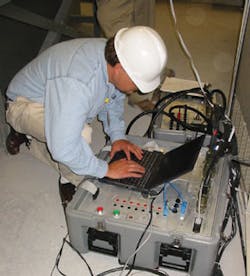PQ Protection Schemes, Sans Batteries
Is the latest in UPS technology a little more than your budget can bear? Don't fret. There are other ways to protect your sensitive equipment from voltage sags, as participants of a special workshop learned last summer. More than 200 industrial and commercial customers from Ohio, Pennsylvania, and New Jersey attended the 11 power quality (PQ) workshops with keynote speaker Mark Stephens, a professional engineer who manages the industrial power quality services activities at EPRI Solutions in Knoxville, Tenn.
“The focus of this class is how to identify the critical circuits in order to implement low-cost type solutions,” Stephens says. “These solutions can result in a big benefit by making the most sensitive sections of a machine or process more robust. We talk a lot about batteryless solutions. We don't encourage a UPS unless it's absolutely needed.”
This is because most power quality events are voltage sags in which battery-based solutions are often not required, he says. Hardware for battery-free solutions typically costs between $500 to $2,000 per application or $10,000 to $50,000 per entire plant site, explains Stephens, but can save the end-user a couple hundred thousand dollars a year in voltage-sag related problems. He also warns that small UPSs, below 3kVA, can often become a maintenance problem because they are spread throughout the facility and must be maintained over time. In particular, Stephens recommends these five battery-free PQ solutions:
Constant voltage transformer. This is basically a ferroresonant transformer with a saturated core. It can supply 100% output when the input voltage has dropped to as low as 40% of nominal. There are now 3-phase input constant voltage transformers that can supply output voltage even if a phase is lost during a voltage sag event.
Dip proofing inverter. This is a capacitor-based storage device that can give 100% output for up to a couple of seconds during a voltage sag, depending on the load. It features a square-wave output instead of a sine wave.
Voltage dip compensator. This is a fast-tap switching transformer. When it senses a voltage sag, it adjusts the taps in a microsecond-type time frame in order to tap up the voltage. It features a sine wave output and yields 100% output when the input voltage has dropped down to about 37% to 50% of nominal depending on the sizing and the model that you choose.
Dynamic sag corrector. This device provides a sine wave-type output, but for voltage sags that are down to about 50% of nominal, it pulls more energy out of the line to rebuild the missing waveform. For voltage sags below 50%, it relies on capacitive energy to rebuild the waveform.
Coil hold-in devices. These components can hold in the electrical/mechanical relays and contactors so they don't drop out. They install right in front of the relay or contactor device.
